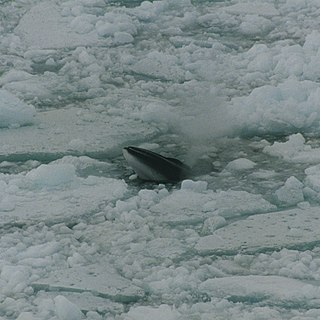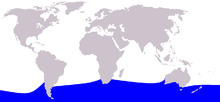
Whales(Balaena) are a widely distributed and diverse group of fully aquatic placental marine mammals. As an informal and colloquial grouping, they correspond to large members of the infraorder Cetacea, i.e. all cetaceans apart from dolphins and porpoises. Dolphins and porpoises may be considered whales from a formal, cladistic perspective. Whales, dolphins and porpoises belong to the order Cetartiodactyla, which consists of even-toed ungulates. Their closest non-cetacean living relatives are the hippopotamuses, from which they and other cetaceans diverged about 54 million years ago. The two parvorders of whales, baleen whales (Mysticeti) and toothed whales (Odontoceti), are thought to have had their last common ancestor around 34 million years ago. Mysticetes include four extant (living) families: Balaenopteridae, Balaenidae, Cetotheriidae, and Eschrichtiidae. Odontocetes include the Monodontidae, Physeteridae, Kogiidae, and Ziphiidae, as well as the six families of dolphins and porpoises which are not considered whales in the informal sense.
Beaked whales are a family of cetaceans noted as being one of the least-known groups of mammals because of their deep-sea habitat, reclusive behavior and apparent low abundance. Only three or four of the 24 existing species are reasonably well-known. Baird's beaked whales and Cuvier's beaked whales were subject to commercial exploitation, off the coast of Japan, while the northern bottlenose whale was extensively hunted in the northern part of the North Atlantic in the late 19th and early 20th centuries.

The minke whale, or lesser rorqual, is a species complex of baleen whale. The two species of minke whale are the common minke whale and the Antarctic minke whale. The minke whale was first described by the Danish naturalist Otto Fabricius in 1780, who assumed it must be an already known species and assigned his specimen to Balaena rostrata, a name given to the northern bottlenose whale by Otto Friedrich Müller in 1776. In 1804, Bernard Germain de Lacépède described a juvenile specimen of Balaenoptera acuto-rostrata. The name is a partial translation of Norwegian minkehval, possibly after a Norwegian whaler named Meincke, who mistook a northern minke whale for a blue whale.

The Antarctic minke whale or southern minke whale is a species of minke whale within the suborder of baleen whales. It is the second smallest rorqual after the common minke whale and the third smallest baleen whale. Although first scientifically described in the mid-19th century, it was not recognized as a distinct species until the 1990s. Once ignored by the whaling industry due to its small size and low oil yield, the Antarctic minke was able to avoid the fate of other baleen whales and maintained a large population into the 21st century, numbering in the hundreds of thousands. Surviving to become the most abundant baleen whale in the world, it is now one of the mainstays of the industry alongside its cosmopolitan counterpart the common minke. It is primarily restricted to the Southern Hemisphere and feeds mainly on euphausiids.

The toothed whales are a parvorder of cetaceans that includes dolphins, porpoises, and all other whales possessing teeth, such as the beaked whales and sperm whales. 73 species of toothed whales are described. They are one of two living groups of cetaceans, the other being the baleen whales (Mysticeti), which have baleen instead of teeth. The two groups are thought to have diverged around 34 million years ago (mya).

Mesoplodont whales are 16 species of toothed whale in the genus Mesoplodon, making it the largest genus in the cetacean order. Two species were described as recently as 1991 and 2002, and marine biologists predict the discovery of more species in the future. A new species was described in 2021. They are the most poorly known group of large mammals. The generic name "mesoplodon" comes from the Greek meso- (middle) - hopla (arms) - odon (teeth), and may be translated as 'armed with a tooth in the centre of the jaw'.

The tropical bottlenose whale, also known as the Indo-Pacific beaked whale or Longman's beaked whale, was considered to be the world's rarest cetacean until recently, but the spade-toothed whale now holds that position. As of 2010, the species is now known from nearly a dozen strandings and over 65 sightings. This is the only species in the genus Indopacetus.

The four-toothed whales or giant beaked whales are beaked whales in the genus Berardius. They include Arnoux's beaked whale in cold Southern Hemispheric waters, and Baird's beaked whale in the cold temperate waters of the North Pacific. A third species, Sato's beaked whale, was distinguished from B. bairdii in the 2010s.

Shepherd's beaked whale, also commonly called Tasman's beaked whale or simply the Tasman whale, is a cetacean of the family Ziphiidae and the only species in the genus Tasmacetus. The whale has not been studied extensively. Only four confirmed at sea sightings have been made and 42 strandings recorded. It was first known to science in 1937, being named by W. R. B. Oliver after George Shepherd, curator of the Wanganui Museum, who collected the type specimen near Ohawe on the south Taranaki coast of New Zealand's North Island, in 1933.

The northern bottlenose whale is a species of beaked whale in the ziphiid family, being one of two members of the genus Hyperoodon. The northern bottlenose whale was hunted heavily by Norway and Britain in the 19th and early 20th centuries. It is one of the deepest-diving mammals known, reaching depths of 2,339 m (7,674 ft) and capable of diving for up to 130 minutes.

The melon-headed whale, also known less commonly as the electra dolphin, little killer whale, or many-toothed blackfish, is a toothed whale of the oceanic dolphin family (Delphinidae). The common name is derived from the head shape. Melon-headed whales are widely distributed throughout deep tropical and subtropical waters worldwide, but they are rarely encountered at sea. They are found near shore mostly around oceanic islands, such as Hawaii, French Polynesia, and the Philippines.

The hourglass dolphin is a small dolphin in the family Delphinidae that inhabits offshore Antarctic and sub-Antarctic waters. It is commonly seen from ships crossing the Drake Passage, but has a circumpolar distribution.

Perrin's beaked whale is part of the toothed whale suborder and is one of over 90 known cetaceans in existence today. Beaked whales are part of the family Ziphiidae, which are the second most diverse group out of all marine mammals with over 20 species currently recognized. Although diverse, little is understood about these timid, deep divers that can dive for up to two hours. The whales are partially named after their beak shaped jaw, which extends from their small head. The genus name Mesoplodon comes from the Greek meanings of meso- (middle), - hopla (arms), - odon (teeth), and may be translated as 'armed with a tooth in the center of the jaw'.

The spade-toothed whale is a very little-known species, the rarest species of beaked whale.

Whale conservation refers to the conservation of whales.

Cetacean strandings in Ghana appear to be becoming more common. Whales washing ashore may be due to ship strike, population dynamics, or an increase in human coverage and reporting. There are at least 28 species of cetaceans — seven baleen whales and 21 toothed whales — in the Gulf of Guinea, of which Ghana’s coast covers 550 km from Aflao to Axim. Scientific approaches to cetacean diversities have not been taken until recently, and 18 species were confirmed during researches.



















